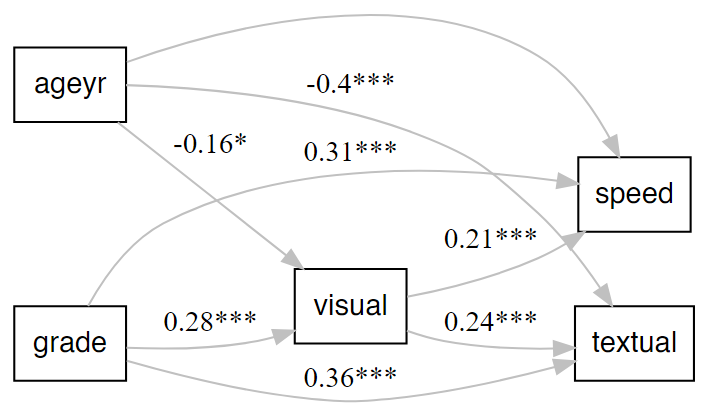Make a quick and decent-looking lavaanPlot.
Arguments
- model
SEM or CFA model to plot.
- node_options
Shape and font name.
- edge_options
Colour of edges.
- coefs
Logical, whether to plot coefficients. Defaults to TRUE.
- stand
Logical, whether to use standardized coefficients. Defaults to TRUE.
- covs
Logical, whether to plot covariances. Defaults to FALSE.
- stars
Which links to plot significance stars for. One of
c("regress", "latent", "covs").- sig
Which significance threshold to use to plot coefficients (defaults to .05). To plot all coefficients, set
sigto 1.- graph_options
Read from left to right, rather than from top to bottom.
- title
Optional title for the plot, positioned at the top. Plain text only; special characters like <, >, & are automatically escaped for Graphviz compatibility. Note: This will override any
labelorlabellocsettings ingraph_options.- note
Optional note or caption for the plot, positioned at the bottom when used alone, or displayed below the title with smaller font when both are provided. Plain text only; special characters are automatically escaped. Note: This will override any
labelorlabellocsettings ingraph_options.- ...
Arguments to be passed to function lavaanPlot::lavaanPlot.
Examples
x <- paste0("x", 1:9)
(latent <- list(
visual = x[1:3],
textual = x[4:6],
speed = x[7:9]
))
#> $visual
#> [1] "x1" "x2" "x3"
#>
#> $textual
#> [1] "x4" "x5" "x6"
#>
#> $speed
#> [1] "x7" "x8" "x9"
#>
HS.model <- write_lavaan(latent = latent)
cat(HS.model)
#> ##################################################
#> # [-----Latent variables (measurement model)-----]
#>
#> visual =~ x1 + x2 + x3
#> textual =~ x4 + x5 + x6
#> speed =~ x7 + x8 + x9
#>
library(lavaan)
fit <- cfa(HS.model, HolzingerSwineford1939)
nice_lavaanPlot(fit)
# With title and note
nice_lavaanPlot(fit, title = "Three-Factor CFA Model", note = "Holzinger-Swineford Dataset")

